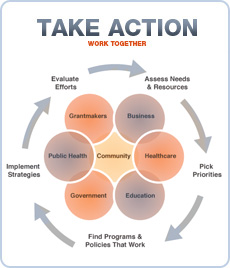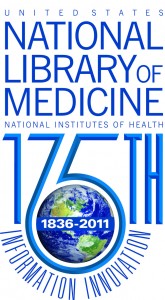
National Black HIV/AIDS Awareness Day is today, February 7th. The CDC reports “Among all racial/ethnic groups, African Americans bear the greatest burden of HIV in the United States. The Centers for Disease Control and Prevention (CDC) estimates that 1 in 16 black men and 1 in 32 black women will be diagnosed with HIV infection during their lifetimes. In 2009, blacks made up 14% of the US population but accounted for nearly half (44%) of all new HIV infections.”
Know the facts about HIV/AIDS in New Orleans and get involved in?áLouisiana.
*Edit* the Gambit blog has more on this topic.

Library Shoebox Float - 2010
The Centers for Disease Control and Prevention have a Carnival Advisory linked from their main webpage at the moment.
A couple of quick points about the page:
New Orleans is the 5th listed city for “most popular Carnival celebrations” after Rio de Janeiro, Brazil; Nice, France; Venice, Italy; and Quebec, Canada. I’ll give them Rio & Venice, but really Nice & Quebec have more popular celebrations than we do?
“Most people participate in Carnival and Mardi Gras to have fun, but these festivities are also associated with certain health risks, primarily from crime, unsafe food, excessive drinking, risky sex, and heat-related illness.” I don’t think this year we’ll have any heat related illness but you never know with our crazy weather.
And, of course, the advisory is written for travelers, not carnival natives/locals who know how to prepare and what to expect.
Local bipedal group Bike Easy is collecting bicycle crash statistics and putting them on the map. (Click image to go to the map).

Bike Easy Bike Map - orange indicates an 'incident'
Behold the “Incidents, Hazards, and Points of Interest” bike map, which is actively collecting incident reports via this form. Posts are moderated and will show up on the map in 24-48 hours. All incidents are displayed anonymously.
If you have been involved in a bicycle incident in the New Orleans area, put it on the map and bring awareness of the number of bicycle crashes that occur in New Orleans each year. And be careful out there.
The New Orleans Health Department has issued a new Health Resource Guide entitled a Guide to Behavioral Health Resources in the Greater New Orleans Area which “provides information on accessing mental health and substance abuse resources in the Greater New Orleans area.” This new guide is in addition to A Guide to No or Low Pay Community Healthcare in Orleans Parish which was released in August 2011. Both brochures are available from the Health Department webpage as PDF downloads.
One final 2011 list, this from our friends at the AAMC:
American Medical News, published by the AMA, has posted “Our most intriguing medical facts of 2011,” drawn from the pages of American Medical News and linked back to the original story.
http://www.ama-assn.org/amednews/site/facts11.htm
The Louisiana Tumor Registry has been awarded 1st Place Data Quality Profile Award from the National Cancer Institute’s SEER program. The Louisiana Tumor Registry has been under the auspice of LSUHSC-NO since 1995; it has been a SEER program since 2001.
An interesting article in the Times Picayune today discussed how the US government is requesting two major scientific publishers (Science and Nature) restrict details about the development of lab-bred bird flu in upcoming publications. The NIH funded research was conducted in the Netherlands and at the University of Wisconsin, in order to study the epidemiology of H5N1 avian influenza.
“…In a statement, Science editor-in-chief Dr. Bruce Alberts said his journal “has concerns about withholding potentially important public health information from responsible influenza researchers” and was evaluating how best to proceed.
Nature’s editor-in-chief, Dr. Philip Campbell, called the recommendations unprecedented.
“It is essential for public health that the full details of any scientific analysis of flu viruses be available to researchers,” he said in a statement. The journal is discussing how “appropriate access to the scientific methods and data could be enabled.”
After review by the US government’s biosecurity advisers, the Department of Health and Human Services requested the two journals not publish the full genetic information of lab bred bird flu, fearing it could fall into the wrong hands.
You would think that due to the First Amendment of the US Constitution, governmental agencies can only request the journals restrict details, and not openly censor the published work. However, according to the American Association for the Advancement of Science (AAAS) (which publishes Science), there are several methods to restrict publication and dissemination of research: classification, export controls, and pre-publication review. “Pre-publication review is sometimes used as a condition for accepting research grants or contracts. These restrictions are usually narrowly-targeted, and do not apply to whole fields of research.”
The AAAS has a useful if dated Issue Brief explaining these methods of publication control in their document “Science and Security in the Post-9/11 Environment-Scientific Publication Policies” (2004), as well as a link to resources and primary documents related to the regulation of scientific information (which is not unprecedented…hello, atomic bomb!).
More Info
20 December 2011 Science press release
http://www.aaas.org/news/releases/2011/1220herfst.shtml
20 December 2011 Nature News: “Fears grow over lab-bred flu”
http://www.nature.com/news/fears-grow-over-lab-bred-flu-1.9692
Growing up, my mother always cooked her stuffing in the turkey. It was delicious, the stuffing not the turkey, that was more of a centerpiece. Little did we know back then that we were living on the edge.
Food poisoning will put a serious crimp in your Black Friday plans, my friend. If you cringe every time you see your Aunt Martha wipe down the counters with a sponge that has been in her sink since the pilgrims landed or you get queasy when you see your nephew touch every dinner roll with his grubby hands before putting one on his plate, check out this site and forward it with offending family members under the guise of sharing recipes.
And if you’re still one of the few who cook their stuffings in the bird, err on the side of caution and invest in a food thermometer. Who doesn’t need a new kitchen gadget anyway?
Surprisingly, just about every 20 seconds a child under age 5 succumbs to the disease pneumonia. ?áIn its 2nd year of existence, the Global Coalition against Child Pneumonia is raising awareness about the disease. It is preventable and there are effective and affordable options that help protect children. The symptoms include but are not limited to: cough, shaking chills, fever, fatigue, and muscle pain. Its symptoms often mimic those of the flu but when it doubt, get checked out.
?áFor more info, visit:
http://worldpneumoniaday.org/
The Trust for America’s Health has released a new report, F as in Fat: How Obesity Threatens America’s Future 2011 which finds that adult obesity is increasing across the Nation. Louisiana is the 5th most obese state with 31.6% of its adult population being obese; we are one of the 16 states with an obesity rate above 30%.
The National Library of Medicine has released a very interesting addition to their History of Medicine collection: World War II-era public health films.
These films cover a wide range of public health issues pertinent to this era. Five animated films starring ÔÇ£Private SnafuÔÇØ inform on issues like Personal Cleanliness, Cleaning Mess Gear and Drinking Water. There are also non-animated films that once educated military personnel on yellow fever, malaria and the use of DDT which was believed would cure common diseases. Interested to learn what information was important for women at war? Don’t worry- there is a film on that as well.
Available films have minor defects and scratches but are definitely worth watching!
The County Health Rankings ÔÇö are a key component of the Mobilizing Action Toward Community Health (MATCH) project. MATCH is a collaboration between the Robert Wood Johnson Foundation and the University of Wisconsin Population Health Institute.

The 50 state reports help public health and community leaders, policy-makers, consumers and others to see how healthy their county is, compare it with others within their state and find ways to improve the health of their community.
A snap shot of New Orleans report is available: http://www.countyhealthrankings.org/louisiana/orleans
Make sure to access the CDC TravelerÔÇÖs Heath site at: http://wwwnc.cdc.gov/travel/default.aspx where you will find health information and useful links for travel to over 200 international destinations.
Healthy voyage!
Yesterday, the National Institutes of Health announced a new study which will follow tens of thousands of cleanup workers and volunteers who participated in the Deepwater Horizon oil spill.
“The GuLF STUDY (Gulf Long-term Follow-up Study) is the largest health study of its kind ever conducted among cleanup workers and volunteers, and is one component of a comprehensive federal response to the Deepwater Horizon oil spill. The study is being conducted by the National Institute of Environmental Health Sciences (NIEHS), part of the National Institutes of Health, and is expected to last up to 10 years Many agencies, researchers, outside experts, as well as members of the local community, have provided input into how the study should be designed and implemented.” from the press release
For more information: http://nihgulfstudy.org/


 myLSUHSC
myLSUHSC


